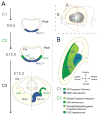Sonic hedgehog functions through dynamic changes in temporal competence in the developing forebrain
- PMID: 20466536
- PMCID: PMC2991106
- DOI: 10.1016/j.gde.2010.04.008
Sonic hedgehog functions through dynamic changes in temporal competence in the developing forebrain
Abstract
Morphogens act during development to provide graded spatial information that controls patterning and cell lineage specification in the nervous system. The role of morphogen signaling in instructing the expression of downstream effector transcription factors has been well established. However, a key requirement for morphogen signaling is the existence of functional intracellular machinery able to mediate the appropriate response in target cells. Here we suggest that dynamic changes in the temporal responses to Shh in the developing ventral telencephalon occur through alterations in progenitor competence. We suggest these developmental changes in competence are mediated by a transcriptional mechanism that intrinsically integrates information from the distinct signaling pathways that act to pattern the telencephalic neuroepithelium.
Figures




References
-
- Rallu M, Corbin JG, Fishell G. Parsing the prosencephalon. Nat Rev Neurosci. 2002;3:943–951. - PubMed
-
- Jessell TM. Neuronal specification in the spinal cord: inductive signals and transcriptional codes. Nat Rev Genet. 2000;1:20–29. - PubMed
-
- Kohtz JD, Baker DP, Corte G, Fishell G. Regionalization within the mammalian telencephalon is mediated by changes in responsiveness to Sonic Hedgehog. Development. 1998;125:5079–5089. - PubMed
-
- Corbin JG, Gaiano N, Machold RP, Langston A, Fishell G. The Gsh2 homeodomain gene controls multiple aspects of telencephalic development. Development. 2000;127:5007–5020. - PubMed
Publication types
MeSH terms
Substances
Grants and funding
LinkOut - more resources
Full Text Sources

